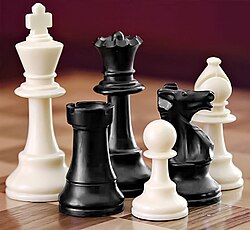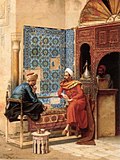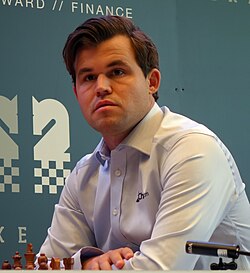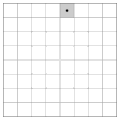Portal:Chess
Introduction
Chess is a board game for two players. It is an abstract strategy game that involves no hidden information and no elements of chance. It is played on a square board consisting of 64 squares arranged in an 8×8 grid. The players, referred to as "White" and "Black", each control sixteen pieces: one king, one queen, two rooks, two bishops, two knights, and eight pawns, with each type of piece having a different pattern of movement. An enemy piece may be captured (removed from the board) by moving one's own piece onto the square it occupies. The object of the game is to "checkmate" (threaten with inescapable capture) the enemy king. There are also several ways a game can end in a draw.
The recorded history of chess goes back to at least the emergence of chaturanga—also thought to be an ancestor to similar games like Janggi, xiangqi and shogi—in seventh-century India. After its introduction in Persia, it spread to the Arab world and then to Europe. The modern rules of chess emerged in Europe at the end of the 15th century, with standardization and universal acceptance by the end of the 19th century. Today, chess is one of the world's most popular games, with millions of players worldwide.
Organized chess arose in the 19th century. Chess competition today is governed internationally by FIDE (Fédération Internationale des Échecs), the International Chess Federation. The first universally recognized World Chess Champion, Wilhelm Steinitz, claimed his title in 1886; Gukesh Dommaraju is the current World Champion, having won the title in 2024. (Full article...)
Selected article -
The zwischenzug (German: pronounced [ˈtsvɪʃənˌtsuːk], "intermediate move"; also called an in-between move or intermezzo) is a chess tactic in which a player, instead of playing the expected move (commonly a recapture), first interposes another move posing an immediate threat that the opponent must answer, and only then plays the expected move. It is a move that has a high degree of "initiative". Ideally, the zwischenzug changes the situation to the player's advantage, such as by gaining material or avoiding what would otherwise be a strong continuation for the opponent. When the intermediate move is a check, it is sometimes called an in-between check, zwischenschach, or zwischen-check.
As with any fairly common chess tactic, it is impossible to pinpoint when the first zwischenzug was played. Three early examples are Lichtenhein–Morphy, New York 1857; Rosenthal–De Vere, Paris 1867; and Tartakower–José Raúl Capablanca, New York 1924. The first known use of the term zwischenzug, however, did not occur until 1933, when the prolific American chess authors Fred Reinfeld and Irving Chernev used it in their book Chess Strategy and Tactics.
(Full article...)General images
Selected image
FIDE world ranking
| Rank | Player | Rating |
|---|---|---|
| 1 | 2839 | |
| 2 | 2807 | |
| 3 | 2784 | |
| 4 | 2779 | |
| 5 | 2776 | |
| 6 | 2776 | |
| 7 | 2771 | |
| 8 | 2766 | |
| 9 | 2748 | |
| 10 | 2748 | |
| 11 | 2746 | |
| 12 | 2745 | |
| 13 | 2743 | |
| 14 | 2742 | |
| 15 | 2742 | |
| 16 | 2739 | |
| 17 | 2738 | |
| 18 | 2736 | |
| 19 | 2736 | |
| 20 | 2734 |
Top 10 WikiProject Chess Popular articles of the month
Did you know...
No recent additions
Reviewed articles
Chess from A to Z
| Index: | A B C D E F G H I J K L M N O P Q R S T U V W X Y Z (0–9) |
| Glossary: | A B C D E F G H I J K L M N O P Q R S T U V W X Y Z |
Topics
Subcategories
Related portals
Related WikiProjects
Associated Wikimedia
The following Wikimedia Foundation sister projects provide more on this subject:
-
Commons
Free media repository -
Wikibooks
Free textbooks and manuals -
Wikidata
Free knowledge base -
Wikinews
Free-content news -
Wikiquote
Collection of quotations -
Wikisource
Free-content library -
Wikiversity
Free learning tools -
Wiktionary
Dictionary and thesaurus









































































